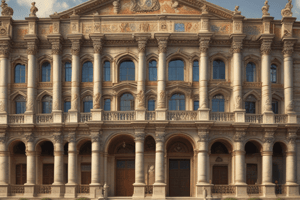Podcast
Questions and Answers
What were some key factors that contributed to the spread of the Renaissance from Italy?
What were some key factors that contributed to the spread of the Renaissance from Italy?
The Renaissance spread from Italy due to factors such as the invention of the printing press, the influence of Renaissance philosophy and art, the rise of capitalism and the middle class, and the impact of Protestant Reformation.
What were some significant events and movements during the Renaissance period?
What were some significant events and movements during the Renaissance period?
During the Renaissance period, significant events and movements included the fall of the Byzantine Empire, the rise of the Catholic Church and the influence of Pope St. Augustine, the feudal system and feudal classes, the Islamic scholars and the Crusades, the Black Death, the development of merchant banking, and the Peace of Lodi.
Which cities in Italy played a major role in the Renaissance?
Which cities in Italy played a major role in the Renaissance?
Florence, Venice, and Genoa were among the major cities in Italy that played a significant role in the Renaissance.
What were some key aspects of Renaissance culture?
What were some key aspects of Renaissance culture?
What were some of the impacts of the Renaissance on Europe?
What were some of the impacts of the Renaissance on Europe?
Study Notes
Factors Contributing to the Spread of the Renaissance
- The invention of the printing press facilitated the distribution of Renaissance ideas and literature across Europe.
- Increased trade and commerce brought wealth to different regions, allowing patrons to support artists and intellectuals.
- The fall of Constantinople in 1453 led to an influx of Greek scholars into Italy, who brought classical knowledge and texts.
- The rise of humanism emphasized the study of classical antiquity and individual potential, spreading through educational reform.
Significant Events and Movements During the Renaissance
- The formation of schools and academies, such as the Platonic Academy in Florence, promoted new learning and philosophical thought.
- The Protestant Reformation, initiated by Martin Luther in 1517, challenged the Catholic Church and spurred further intellectual and cultural movement.
- The Medici family's patronage of the arts and involvement in politics significantly influenced the cultural landscape of Florence.
- Major artistic movements, including the High Renaissance, showcased masters like Leonardo da Vinci and Michelangelo, emphasizing realism and human emotion.
Major Italian Cities in the Renaissance
- Florence, considered the cradle of the Renaissance, was the center for art and culture due to wealthy patrons like the Medici.
- Venice became a vital hub for trade and culture, influencing art through its unique mix of Eastern and Western traditions.
- Rome became a focal point for Renaissance art, especially after becoming the papal capital, with notable projects like St. Peter's Basilica.
- Milan saw advancements in architecture and military engineering, with figures such as Leonardo da Vinci contributing to its cultural development.
Key Aspects of Renaissance Culture
- Humanism, a movement focusing on classical studies, emphasized individual achievement and the study of humanities.
- Advancements in visual arts, including the use of perspective, anatomy, and chiaroscuro, transformed the depiction of space and human figures.
- Literature flourished through authors like Petrarch and Machiavelli, who explored human nature, politics, and ethics.
- A revival of classical architecture emphasized symmetry, proportion, and the use of columns and domes in building designs.
Impacts of the Renaissance on Europe
- Shifted the focus of education from religious studies to secular subjects, laying the groundwork for modern education systems.
- Sparked a spirit of inquiry and skepticism, pushing the boundaries of science and leading to advancements in various fields such as astronomy and anatomy.
- Influenced religious thought and practice, contributing to the Reformation and the questioning of ecclesiastical authority.
- Encouraged national identities to develop in Europe, as rising nation-states embraced cultural distinctions and artistic expressions.
Studying That Suits You
Use AI to generate personalized quizzes and flashcards to suit your learning preferences.
Description
Test your knowledge of the Western Worldview, from Ancient Greece philosophers to the fall of the Byzantine Empire and the rise of the Renaissance in Italy. Explore topics such as logic and reason, the Middle Ages, the Catholic Church, feudalism, Islam, and the impact of the Crusades and the Black Death. Discover the significance of Renaissance cities like Florence, Venice, and Genoa, and learn about key historical figures such as St. Augustine and the Avignon Papacy.




